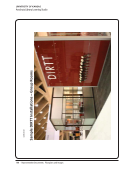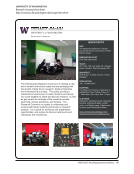SPEC Kit 327: Reconfiguring Service Delivery · 73
Anticipated Additions, Closures, Consolidations, or Other Reconfigurations
33. In the next three years, do you anticipate that any staffed service point in your main library or
that any branch that reports to the main library will be added, closed, consolidated, or otherwise
reconfigured? N=59
Yes 49 83%
No 10 17%
Comments
Answered Yes
A new Chemistry Library is in the planning stages.
Actively planning to introduce appointment reference model to one underutilized branch library located in most heavily
used classroom building on campus. May expand appointment model elsewhere later.
Fine Arts hopes to repurpose their former rare book room space in 2012. The Digital Media Lab will be reconfigured in
the next three years. (They reconfigure almost yearly.) The main library anticipates closing the 3rd floor service point in
Gov Docs. Staff will still provide service but there won’t be a service desk.
Gov Pubs/Maps and Law will integrate with our academic liaison group. New learning commons opens in summer 2012.
We do not plan a staffed service point in the commons. Conversations are occurring now about how our service model
will evolve to support the new commons.
High likelihood that circulation desk and reference desks will merge. Currently some dozen yards apart, but
reconfiguration would free space for users while providing more focused staff presence for the user.
In December 2010, we hired a Director of Special Collections to merge and lead what had previously been two separate
special collections operations: our Special Collections Department and our Urban Archives Department. As a part of this
major reorganization and consolidation, in 2011–2012 we anticipate consolidating our two special collections reading
rooms into one. This will enable us to provide more consistent, higher quality reference services and make better use of
our existing staff to redistribute their work load more equitably across public services, exhibits, outreach, processing,
cataloging, and acquisition. The second (closed) reading room will be reconfigured as teaching space for class visits to
special collections. In addition, we are just starting to work on reconfiguring our digitization services. With the creation
of a new Digital Library Initiatives Department in December 2010, we are starting to explore how to offer digitization
on demand and other related services to library and special collections users. Our university currently expects to build
a new main library within the next three to five years. Even if it takes longer, we may try some additional service desk
configurations, as described below.
In Fall 2011 a large new learning commons will open adjacent to the main library building. This commons is connected
on two levels to the main library. In addition, the new commons is managed by the library. There will be an information
and advising service desk in the new commons, staffed and managed by the library.
In main library, microforms currently has dedicated service point. Staff and services associated with microforms are likely
to be integrated with main research and instruction service point. We would like to consider additional reconfigurations
Anticipated Additions, Closures, Consolidations, or Other Reconfigurations
33. In the next three years, do you anticipate that any staffed service point in your main library or
that any branch that reports to the main library will be added, closed, consolidated, or otherwise
reconfigured? N=59
Yes 49 83%
No 10 17%
Comments
Answered Yes
A new Chemistry Library is in the planning stages.
Actively planning to introduce appointment reference model to one underutilized branch library located in most heavily
used classroom building on campus. May expand appointment model elsewhere later.
Fine Arts hopes to repurpose their former rare book room space in 2012. The Digital Media Lab will be reconfigured in
the next three years. (They reconfigure almost yearly.) The main library anticipates closing the 3rd floor service point in
Gov Docs. Staff will still provide service but there won’t be a service desk.
Gov Pubs/Maps and Law will integrate with our academic liaison group. New learning commons opens in summer 2012.
We do not plan a staffed service point in the commons. Conversations are occurring now about how our service model
will evolve to support the new commons.
High likelihood that circulation desk and reference desks will merge. Currently some dozen yards apart, but
reconfiguration would free space for users while providing more focused staff presence for the user.
In December 2010, we hired a Director of Special Collections to merge and lead what had previously been two separate
special collections operations: our Special Collections Department and our Urban Archives Department. As a part of this
major reorganization and consolidation, in 2011–2012 we anticipate consolidating our two special collections reading
rooms into one. This will enable us to provide more consistent, higher quality reference services and make better use of
our existing staff to redistribute their work load more equitably across public services, exhibits, outreach, processing,
cataloging, and acquisition. The second (closed) reading room will be reconfigured as teaching space for class visits to
special collections. In addition, we are just starting to work on reconfiguring our digitization services. With the creation
of a new Digital Library Initiatives Department in December 2010, we are starting to explore how to offer digitization
on demand and other related services to library and special collections users. Our university currently expects to build
a new main library within the next three to five years. Even if it takes longer, we may try some additional service desk
configurations, as described below.
In Fall 2011 a large new learning commons will open adjacent to the main library building. This commons is connected
on two levels to the main library. In addition, the new commons is managed by the library. There will be an information
and advising service desk in the new commons, staffed and managed by the library.
In main library, microforms currently has dedicated service point. Staff and services associated with microforms are likely
to be integrated with main research and instruction service point. We would like to consider additional reconfigurations






















































































































































































































